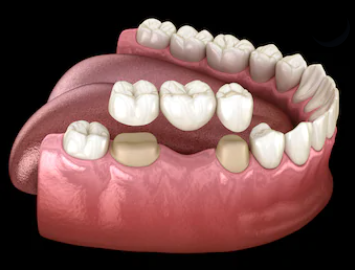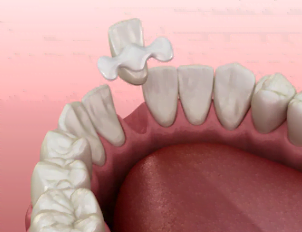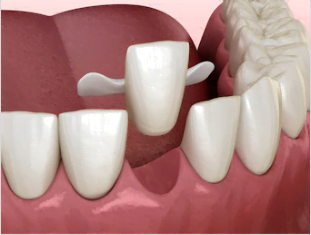Dentures can be made on teeth, on implants, directly on the gum (dentures) or supported on the teeth and gum (removables)
Dentures on Teeth
Regarding the amount of teeth it will replace, they can be single, partial, or total.
Dentures on single teeth are usually made of porcelain.

Partials can be made of either porcelain (fixed prosthesis or fixed bridge) or resin (removable partial denture or mobile bridge).


There are also adhesive prostheses that are used when the patient does not want or cannot undergo treatment with dental implants. The great advantage of this type of prosthesis is that they preserve the neighboring teeth. The disadvantage is that it is more likely to come loose since it is glued to a smaller area.



Questions asked on the internet about fixed prosthesis or fixed bridge
1 – My bridge came loose. What could have happened?
Re: The vast majority of the time, when a fixed prosthesis comes loose, the problem is one of infiltration. Most likely the part was not well fitted and oral fluid infiltration occurred. This fluid is contaminated and often causes caries, and if a zinc phosphate cement has been used, it may have degraded, leading to looseness. The ideal is, when taking the impression, to anesthetize the gums, place a retractor wire (which pulls the gums a little away from the tooth), and make the copy with the material. In this way the material will faithfully copy the entire contour, and the piece, which must be made in a good prosthetic laboratory, will fit perfectly. Furthermore, the cementation must be done with resin cement that does not degrade in the oral environment.
Resin dentures supported on the gum (dentures)

Dentures are pieces made up of a resin base and 14 teeth attached to it. This base should be characterized with different shades of pink and red to look natural. The teeth should have a good naturalness as well. We use Phonares teeth because they are the most natural teeth available in the Brazilian market today.

Denture supported on tooth and gum (Removable partial denture or mobile bridge)

Removable prosthetics or bridgework are pieces composed of a metal part and an acrylic part. The metal part has clamps that attach to the natural teeth. The acrylic part has a resin base that imitates the gums and the teeth that are attached to this base.
Questions? Send us a message via WhatsApp
Information on fixed prosthetics for dental students
Fixed Prostheses are prostheses that replace one or more teeth that have been lost or destroyed, due to caries or trauma, and are fixed in the mouth, with the aim of rehabilitating chewing function and aesthetics for the patient. Some examples of fixed prostheses:
- Crown: Restoration that surrounds the crown of the tooth, and can be total or partial.
- Full Crown: Involves all the faces of the tooth, up to the gingiva or gingival sulcus;
- Partial Crown: It does not involve all the faces of the tooth, so we have: Inlay when the patient does not need to rehabilitate any cusps or groove, Onlay when the restoration already involves one or more cusps, Overlay when it needs to cover all the cusps but does not necessarily cover all the faces or come close to the gingiva.
- Veneers: Today, veneers are well known in dentistry. They cover the faces of the teeth and give them a better appearance when smiling. They are indicated for teeth with stains, cracks, slightly crooked teeth, and spaces between them.
- Fixed partial dentures: These are prosthetics that need to prepare the neighboring teeth in the prosthetic space in order to replace the lost tooth. The most indicated to rehabilitate the patient with this type of prosthesis, is when the teeth to be prepared already have some wear or a large restoration, because nowadays we avoid spending healthy teeth.
- Fixed prosthesis on implants: These are prostheses that can be screwed or cemented, depending on the prosthesis the patient chooses.
You should never make a fixed prosthesis with an implant together with the patient’s tooth, because it is too much load when chewing and can damage the periodontium. So we always do it if it’s both implants, or both teeth. Always evaluating how many elements you need to implant or how many teeth you need to prepare.
We have as materials to work with this type of prosthesis the resin that is used more for temporaries because of its low quality, the metal that nowadays is not much used because of its aesthetics, the metal-plastic that is the metal crown with resin, the metal-ceramic that is more used, and the pure ceramics that are more aesthetic but have the disadvantage that they are more expensive.
Components of a fixed partial denture:
- Abutment: it is the patient’s tooth that will be prepared to receive the prosthesis;
- Prosthetic space: space of the element loss;
- Pontic: element that occupies the space of the missing tooth;
- Retainers: this is the part of the prosthesis that will be cemented to the abutment;
- Connectors: Connect the retainer to the pontic.
The pontic when implanted in the oral cavity, must allow the patient to do a good hygiene, and not accumulate plaque. For this we need to choose the best shape, so that there is no accumulation of food debris and biofilm. We have 4 types of pontic:
- Bullet shape: Rounded conical, suitable for small lower ridge, has minimal contact with the bone crest. If the ridge is wider, it is contraindicated by the ease with which it retains food;
- Inclined plane: It is larger in the vestibular and is close to the gingiva, in the lingual it is far away. It facilitates hygienization and is indicated for anterior and posterior. It is the most suitable type of pontic for all cases;
- Hygienic pontic: It has no contact with the ridge, it looks like a cut occlusal, and it is not indicated for anterior teeth, because it is not aesthetic at all. It can be used on the lower back that doesn’t show up as much;
- Saddle pontic: Hugs the ridge on the buccal and lingual side. Contraindicated in any situation, because it is not possible to have good sanitation with this pontic.
The connectors can be rigid or semi-rigid. The rigid ones are welded connectors, when there is no way to move the prosthesis. The semi rigid ones are made with a socket, indicated for extensive prosthesis, so that when it is necessary to remove, only a part can be removed, and not the whole piece.
Intraradicular retainers
To rehabilitate a patient with intraradicular retainers, his or her canal must be very well treated, the canal must be prepared to receive it, i.e. it must be partially emptied. A minimum amount of 4mm of gutta percha, if possible, should be kept in the apical third to avoid displacement of the obturation or infiltration, thus not compromising the success of the endodontic treatment We make retainers in situations where the dental crown is totally destroyed to have a better fixation and security of the prosthesis. To implement it we need to know about:
- Anatomic crown: everything from the cemento-enamel line to the occlusal;
- Anatomical root: from the CE line to the apex;
- Clinical crown: Whatever is from the alveolar bone crest to the crown (outside the alveolar bone);
- Clinical root: the entire portion around the alveolar bone, from the alveolar bone crest to the apex.
- The clinical root has to be greater than or equal to the clinical crown to succeed in the procedure, so we can say that it is the clinical root that will show us whether or not we can rehabilitate.
Ante’s Law: It tells us how many teeth we can prepare for rehabilitation with fixed prosthetics. The root surface of the abutment teeth always has to be greater than or equal to the root surface of the tooth being replaced. So the sum has to be greater than or equal to the root of the tooth that I am replacing.
This shows if the prosthesis will support mechanically, if it is not respected it can yield or fracture.
The width of the pin should be ⅓ of the diameter of the root remnant, with an elliptical shape and not cylindrical, as this helps with the stability of the prosthesis.
The dentist may choose to place a cast metal retainer, or a pre-fabricated pin. In the first case, the retainer is custom-made to fit the canal with its coronal and root portion fused together, while in the second case, the canal is widened to fit the selected pin configuration and the coronal core is built with a material applied directly over the remaining retainer/tooth assembly.
Fused root retainers can be metal or ceramic, with rigidity and corrosion being the main characteristics that must be taken into consideration when selecting metal retainers. They are indicated in cases of extensive rehabilitations, tooth realignment, and in elliptical or excessively conical canals in which the pre-fabricated retainer does not adapt firmly to the canal walls, resulting in greater cement thickness. The advantages of cast retainers are related to their high rigidity and better adaptation to the channel, which favors anti-rotational characteristics. Their disadvantages are related to additional dentin reduction to accommodate the full crown and to exclude recesses of the coronary chamber, in addition, they require a greater number of clinical sessions and higher costs due to laboratory procedures that make the procedure more complex. Prefabricated root canal retainers can be classified into metallic and non-metallic (carbon fiber, ceramic, and fiberglass). The metallic ones present a more favorable clinical history, but the search of the patients for aesthetics has provided a diversification of the materials used in the manufacture of the prefabricated pins
Prefabricated pins are mainly indicated for teeth with small circular canals. The advantages of this system are related to the favorable esthetics in many cases and the simplicity/rapidity of the technique due to the lack of laboratory involvement.
The goal of intra-radicular retainers can only be achieved with a sealing cement to increase retention, aid in sealing along the canal and contribute to the even distribution of forces between the core and the canal wall. The most commonly used cements are zinc phosphate, glass ionomer, and resin cements. These cements have been used successfully, but none of them ensures clinical success when the preparation of the retention system is inadequately performed.
Types of termination line:
- Knife blade: Used in the preparation for total metallic crown, with conical trunk burs. Indicated for lingual faces of mandibular pre molars and severely inclined teeth. Its advantage is that it preserves the tooth structure and the disadvantage that it is difficult to control the location of the margin (good impression, but cannot see the termination line);
- Simple Chamfer: Used in the preparation of metal, metal-ceramic, and metal-plastic full crowns, with rounded conical trunk drills. Indicated in the proximal and lingual. Its advantage is that it preserves the tooth structure, and the disadvantage is that it cannot be used where it is aesthetic;
- Wide Chamfer: Used in the preparation of metal-plastic, metal-ceramic, metal-free, hollow crowns, with rounded conical trunk drills. Indicated on all tooth faces, and on anterior teeth. Its advantage is the esthetics that this preparation offers for more aesthetic crowns, and its disadvantage is that it wears down the tooth a lot;
- Broad bevel: And for the same indications as the broad bevel, the difference is that we make a bevel on the vestibular side of the tooth with tapered cone-shaped burs, for better adaptation of the piece and to improve the esthetics of anterior teeth.
Principles of optimal occlusion: TMJ in normal relation.
- Simultaneous and homogeneous bilateral RC/MI C contacts:
When you close the mouth, the two sides touch each other (teeth) and close with the same intensity, together.
- Axial loads: There must be the same load parallel to the long axis of the tooth, so that there is no damage to the periodontium.
- Laterality movement to the working side without interference:
- Side of chewing is the chewing cycle: in canine guide;
- Partial group function is up to the 2nd pre molar;
- Total group function from the 1st molar on.
Interference is when one tooth gets in the way of the others touching antagonist. The canine always has to play.
- Laterality movement to the balancing side without interference:
- It is the opposite side of chewing;
- No tooth contact of any kind can occur;
- Protrusive movement of disocclusion of the posterior: In protrusion the posterior disocclude 1.1 mm.
- Principles of mutual protection: The posterior teeth protect the anterior teeth, and the anterior teeth protect the posterior teeth.
To set up the treatment plan for the patient, we need to evaluate the supporting teeth, crown to root ratio, root configuration, root surface area, and evaluate the ante law.

